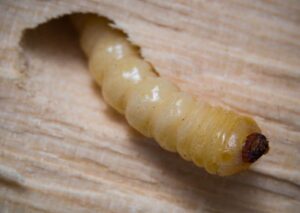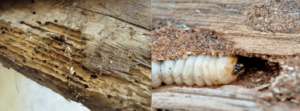Timber Treatment

The word “woodworm” refers to the larval stage of a variety of wood-boring insect species that multiply and grow in wood.
The mature beetle deposits its eggs on the wood’s surface’s fissures and cracks. The eggs hatch into hungry larvae which bore into the wood and feed on the cellulose of wood for many continuous years after which they travel to the surface of the wood by creating chambers and form pupa and turn into adult beetles and wood-boring insects that tunnel to exit the wood.
This life cycle continues unless it is found and eradicated. Deterioration and a loss of strength are caused by woodworm within the wood. Holes and tunnels make the timber weaken and decay.
The most common woodworms are the Common Furniture Beetle (Anobium punctatum) and Death Watch Beetle (Xestobium rufovillosum).

Tell-Tale Signs of Woodworm Infestation
There are many tell-tale signs that timber has been infested with woodworm, which include the following:
- Small holes in the timber – Woodworm drill tiny holes in the timber, leaving small mounds of dust by each hole. Beetle larva are the culprits and a colony can make short work of joists and rafters, causing a lot of damage.
- Presence of adult beetles in the home – Particularly near affected timber, if you spot these insects, you should commission a survey to determine the presence of woodworm, wet and dry rot.
- Cream coloured egg larvae – Another sure sign that beetle larvae are present, these eggs are usually grouped in small colonies.
- Crumbly timber edges – Woodworm typically affects the ends of timber sections and the wood tends to crumble.
- Dead adult beetles – If you notice these black insects on the floor, this could be a sign that woodworm is present.
The best way to identify the species is to call in an expert; at London Damp Specialists, we have the know-how and the equipment to identify and eliminate all types of woodworm, as well as wet and dry rot. In the event we find woodworm, we recommend treating all the timber in the house, as there could be other sites where eggs have been laid, but there are no signs at an early stage of development, as well as wet and dry rot.
What to do if you think you have woodworm
London Damp Specialists Ltd are experts in all areas of diagnosing woodworm and administering the best timber treatment. Get in touch with us today to discuss your requirements and let us visit your property or business to analyse the problem and come up with a suitable timber treatment. Call our experienced team today on 020 7458 4864.
How we treat woodworm
Woodworm infestation can be easily rectified by an expert team.
Our most recent methods make it simple and quick to determine whether an infestation exists. The medications we carry for the preservation and killing of woodworms help to protect all the healthy woodwork of the household and other buildings.
If a woodworm has been discovered, we will most likely recommend that all timber in your property be treated against woodworm and all types of wood-boring insects.

Although the treatment and removal of woodworm is possible with the use of a variety of different solutions, at London Damp Specialists we always use the highest grade and the most effective water-based insecticide treatments to kill the woodworm and insects damaging your home.
One big advantage of using water-based insecticides is that the home occupants can re-enter the treated property just a few hours after spraying the treatment.
By immediately applying the woodworm solution to the wood, any woodworms or their eggs that are within or close to the treated wood’s surface are eliminated. It will take about one hour for all of the spray to absorb into the timber. Depending on the cycle of the woodworm’s life this can be a while after the treatment has been applied.
All woodworm treatments carried out by London Damp Specialists are guaranteed for 30 years giving you complete peace of mind that the treatment is effective.
For advice call our experienced team today on 020 7458 4864.
Customer Testimonials
The simple answer is yes. Basement tanking in London is a very common requirement due to the moisture in the ground and there are numerous systems for waterproofing a basement/cellar.
Yes, at London Damp Specialists, we treat all forms of timber rot including woodworm.
Ensuring the success and longevity of damp treatment requires some post-treatment care on your end. Here’s what you should consider:
Ventilation: Keep rooms well-ventilated to prevent moisture buildup.
Heating: Maintain a consistent indoor temperature to prevent condensation.
Regular Cleaning: Clean surfaces to prevent mould and dust buildup.
Humidity Control: Monitor and maintain indoor humidity levels.
Prompt Repairs: Address leaks and plumbing issues promptly.
Landscape Drainage: Ensure proper landscaping for good drainage.
Inspections: Periodically check treated areas for issues.
Follow Advice: Adhere to maintenance recommendations from specialists.
Appliance Ventilation: Ensure proper ventilation for appliances.
Check External Factors: Monitor external factors that caused the issue.
Professional Checks: Schedule periodic inspections for ongoing protection.
At London Damp Specialists, we prioritise your safety and comfort. For minor treatments, there’s usually no need to vacate your home. However, in cases requiring more extensive or invasive solutions, we might recommend temporary evacuation to ensure effective treatment and your well-being. We’ll communicate clearly about the process and options, keeping you informed every step of the way. Your satisfaction and safety are our utmost concern.
Yes, any environment that is damp and humid will attract pests such as mice, rats and cockroaches. Not only that, mould is a health hazard that can lead to serious respiratory issues with extended exposure. Call London Damp Specialists on 020 7458 4864 or complete the form on your website.
The best time to waterproof a basement is during initial construction, although we can carry out basement tanking in London at any time. There are numerous ways to waterproof a below- ground structure; the most common is a Type C cavity membrane system that captures and removes water.
Our 5 Step Process
01
Initial Consultation
Tell us about your damp issue and we’ll guide you on next steps. It's an opportunity for you to ask questions and gather information.
02
Site Visit
Next, we visit your property to find the root cause of the issue. We’ll also assess the local environment, and take measurements or observations.
03
No Obligation Quote
Then we’ll send a detailed estimate of the costs involved, with no hidden extras, and provided to you without any commitment. You can review the financial aspect before making any decisions.
04
Work Carried Out
Our expert team carries out the work as planned, to the agreed timeline and quality standards, with minimum disruption to you.
05
Payment
The last step is payment, once the work’s complete, your home is dry and you’re satisfied with the results.